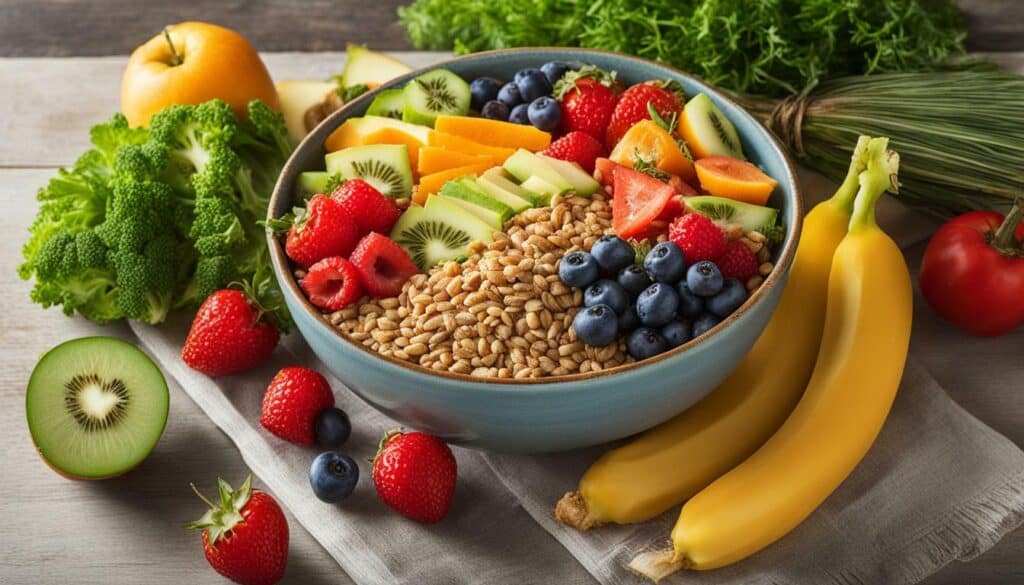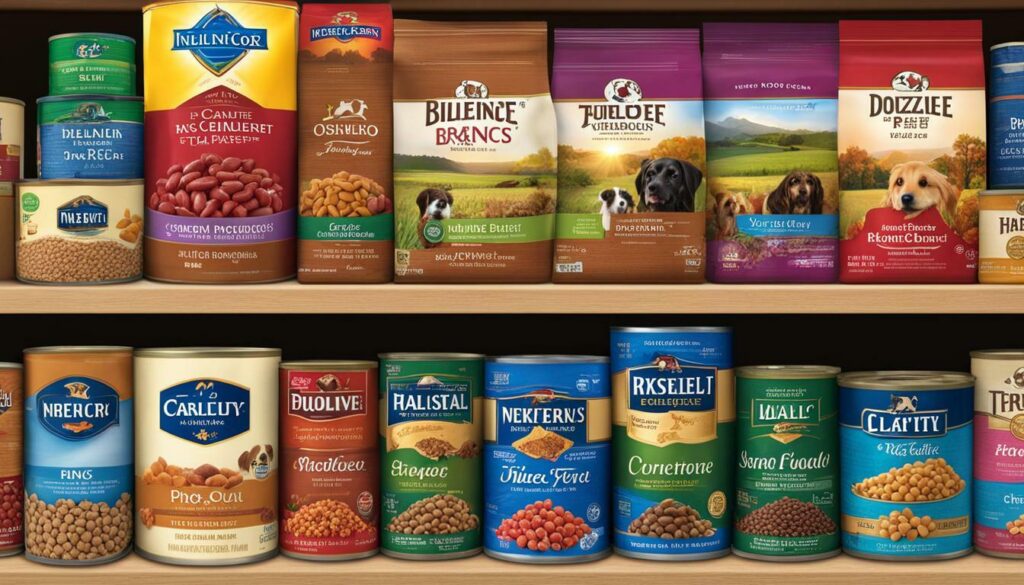The Ultimate Guide to Canine Nutrition: Choosing the Best Dog Food

Welcome to my comprehensive guide on canine nutrition. As a journalist specializing in pet care and health, I have researched and compiled essential information to help you make informed decisions regarding your furry friend’s diet. In this guide, we will explore the factors to consider when choosing the best dog food, including their nutritional needs, different types of dog food, and how to decode dog food labels.
Canine nutrition is crucial for maintaining your dog’s health, and choosing the right dog food is the first step. With so many options on the market, it can be overwhelming to make a choice. That’s why I’ve created this guide to assist you in selecting the best dog food for your pet’s unique needs.
Throughout this guide, we will use SEO relevant keywords such as canine nutrition, dog food, and best dog food to ensure that you have access to the most relevant information available. Additionally, an image of a happy dog with a food bowl will be included with the alt tag “best dog food” to help illustrate the importance of proper nutrition for your pet.
Understanding the basics of canine nutrition is essential for choosing the best dog food for your furry friend’s health. Dogs require a balanced diet that provides them with all the essential nutrients they need to thrive.
Dogs require six essential nutrients: protein, carbohydrates, fats, vitamins, minerals, and water. Each nutrient plays a crucial role in maintaining their health and well-being. Protein is necessary for building and repairing muscle tissue, while carbohydrates provide energy. Fats help with the absorption of vitamins and minerals, and vitamins and minerals are essential for various bodily functions.
Feeding your dog a balanced diet that provides them with all these essential nutrients is crucial for their overall health. A balanced diet should contain a specific ratio of protein, carbohydrates, and fats, depending on your dog’s age, breed, and activity level.
The Importance of Feeding a Balanced Diet
A balanced diet is critical to meeting your dog’s nutritional needs. A balanced diet should contain a specific ratio of protein, carbohydrates, and fats, depending on your dog’s age, breed, and activity level. Providing your dog with a balanced diet can help prevent health issues such as obesity, heart disease, and diabetes.
It’s important to note that different dogs may require different ratios of nutrients in their diet. For example, a highly active dog may require more protein and carbohydrates than a dog that is less active. Working with your veterinarian can help ensure that your dog’s diet is tailored to their individual needs.
Next, we will delve into how to decode dog food labels to ensure you are choosing a balanced and healthy dog food option.

Choosing the right dog food can be a daunting task, especially when deciphering the labels on dog food packaging. As a responsible pet owner, you want to provide your dog with the healthiest and most nutritious food possible. That’s why understanding how to decode dog food labels is crucial.
When browsing through the numerous dog food options at the pet store, you’ll often see terms like “healthy,” “natural,” and “premium” splashed across the packaging. However, these terms can be misleading and do not necessarily indicate a high-quality dog food.
One way to determine whether a dog food is healthy is to check the ingredients list. Look for high-quality protein sources, such as chicken, turkey, lamb, or fish, as the main ingredient. Avoid dog food with fillers, such as corn and wheat, and added sugars, which can lead to obesity and other health issues.
Another consideration when selecting dog food is whether it contains artificial preservatives, colors, or flavors. Natural dog food options are typically free of these additives and tend to be healthier for your dog in the long run.
It’s important to note that premium dog food does not necessarily equate to healthy dog food. Some premium dog foods may contain unnecessary and potentially harmful ingredients. Always read the label carefully and do your research before making a purchase.
By understanding how to decode dog food labels and being aware of what to look for in a healthy dog food, you can ensure your pup is receiving the nutrition they need to thrive.

There are various types of dog food available, each catering to different dietary preferences and needs. It’s important to consider the specific requirements of your dog when choosing the type of food to feed them.
Grain-free dog food is a popular option for dogs with grain sensitivities or digestive issues. This type of dog food is made without grains such as wheat, corn, or soy. Instead, ingredients like sweet potatoes, peas, and lentils are used as sources of carbohydrates.

High protein dog food is designed to provide dogs with elevated levels of protein to support their active lifestyle. This type of dog food typically contains a higher percentage of animal-based protein sources, such as chicken, beef, or fish.
When choosing a type of dog food, it’s important to consult with your veterinarian to ensure it meets all of your dog’s nutritional needs.
Evaluating Dog Food Ingredients
The ingredients in dog food play a crucial role in determining its quality and nutritional value. As a responsible dog owner, it’s essential to know how to evaluate dog food ingredients to choose a healthier and more balanced option for your furry friend.
When selecting dog food, it’s crucial to read the label carefully. Look for dog food that has a named protein source like chicken, beef, or lamb as the first ingredient. This ensures that the food contains a sufficient amount of quality protein to meet your dog’s nutritional needs. Avoid dog food that lists meat by-products or unnamed meat sources as the primary ingredient, as these are vague and may contain lower quality ingredients.
Whole grains like brown rice and oatmeal can provide valuable nutrients and fiber for dogs. However, if your dog has a grain sensitivity, look for grain-free dog food options. These typically contain alternative sources of carbohydrates, such as sweet potatoes or peas.
Natural dog food options often contain high-quality ingredients like whole meats, fruits, and vegetables. Avoid dog food that contains artificial preservatives, colors, or flavors. Premium dog food brands often feature better quality ingredients and more rigorous quality control standards.
It’s also essential to be mindful of the fat content in your dog’s food. While some fat is essential for a healthy diet, too much can lead to obesity and related health issues. Look for dog food with a moderate fat content and avoid brands that rely on excess fat to enhance the taste.
| Ingredients to Look For | Ingredients to Avoid |
|---|---|
| Whole meats like chicken, beef, and lamb | Meat by-products and unnamed meat sources |
| Brown rice, oatmeal, and other whole grains | Artificial preservatives, colors, and flavors |
| Fruits and vegetables | Excessive amounts of fat |
With proper evaluation of dog food ingredients, you can ensure that your furry friend is consuming a healthy and nutritious diet.

Just like humans, dogs have specific nutritional requirements that vary depending on their age and size. Providing a balanced and appropriate diet is essential to keep your furry friend healthy and happy throughout their life. Here are some important factors to consider when it comes to canine nutrition:
Nutritional Needs by Age
Puppies require a balanced diet with adequate protein and fat to support their growth and development. As they mature into adult dogs, their nutritional needs change, and they require a diet that’s lower in fat and higher in fiber to maintain their weight and overall health.
Senior dogs often have special nutritional requirements due to their age-related health concerns. They often need a diet that’s lower in calories and fat but higher in protein to maintain their muscle mass and promote healthy aging.
Nutritional Needs by Size
Small dogs have faster metabolisms and higher energy needs compared to larger breeds. Thus, their diets should be higher in fat and calories to meet their energy requirements.
Large breed dogs are at risk of certain health conditions, such as joint problems. Therefore, their diet should consist of moderate calorie and fat levels and high levels of glucosamine and chondroitin to support joint health.
Feeding a Balanced Diet
Regardless of age or size, every dog’s diet should be balanced to meet their nutritional needs. A balanced diet means providing your dog with the right amounts of protein, carbohydrates, fats, vitamins, and minerals. It’s crucial to feed your pup a high-quality, balanced dog food that’s appropriate for their age and size.

By considering your dog’s nutritional needs based on their age and size, you can ensure that they receive the appropriate amount of nutrients to keep them healthy. Balanced nutrition is crucial for a happy and healthy pup.
Dog Food Allergies and Sensitivities
Just like humans, dogs can develop allergies or sensitivities to certain ingredients in their food. Common allergens in dog food include wheat, soy, corn, and dairy products. If your dog displays symptoms such as itching, excessive licking, or gastrointestinal issues after eating, they may have a food allergy or sensitivity.
Grain-free dog food has become popular in recent years as a solution for dogs with food allergies or sensitivities. This type of dog food is made without grains such as wheat, corn, or soy, which are common allergens.
Natural dog food is another option for dogs with food allergies or sensitivities. Natural dog food is made without artificial colors, flavors, or preservatives and may also be free of common allergens.
It’s important to consult with your veterinarian if you suspect your dog has a food allergy or sensitivity. Your vet can help identify the specific allergen and recommend an appropriate dietary solution.

Determining Portion Sizes and Feeding Schedule
Knowing how much and how often to feed your dog is crucial for maintaining their health. Portion sizes and feeding schedules should be determined based on your dog’s weight, age, and activity level. A balanced dog food should provide all the essential nutrients your dog needs to thrive, without overfeeding or providing excess calories.
A general guideline for portion sizes is to feed your dog 2-3% of their body weight per day. For example, a 50-pound dog would need 1-1.5 pounds of food per day. However, this can vary depending on factors such as breed, metabolism, and activity level, so consulting with your veterinarian is recommended to determine the appropriate portion sizes for your dog.
In addition to portion sizes, establishing a regular feeding schedule is important for maintaining proper digestion and preventing overeating. Most adult dogs do well with two meals per day, while puppies may require more frequent feeding. Avoid free-feeding your dog, which can lead to obesity and other health issues.

When choosing a balanced dog food, look for options that provide a complete and balanced nutrient profile. This should include adequate protein, fat, carbohydrates, vitamins, and minerals for your dog’s specific needs. Avoid overfeeding or providing excess calories, as this can lead to obesity and other health problems.
By following these guidelines for determining portion sizes and feeding schedules, you can help ensure your dog receives the appropriate nutrition for their health and well-being.
Popular Dog Food Brands
Choosing the best dog food brand can be challenging, as there are so many options available. Here are some of the most popular dog food brands known for their quality, nutrition, and reliability:
| Brand Name | Features | Best For |
|---|---|---|
| Blue Buffalo | High-quality, natural ingredients, no by-products, no artificial preservatives | Dogs with food sensitivities |
| Hill’s Science Diet | Formulated by veterinarians, high-quality ingredients, balanced nutrition | Dogs with specific nutritional needs |
| Purina Pro Plan | Wide variety of options to suit different dietary needs, real meat as the first ingredient | Dogs with different needs and preferences |
| Merrick | Whole food ingredients, no fillers, high-quality proteins | Dogs with food sensitivities |
| Wellness | All-natural ingredients, no fillers or artificial additives, high-quality proteins | Dogs with specific nutritional needs |
These brands offer a variety of options, including healthy dog food, premium dog food, and the best dog food for dogs with food sensitivities. It’s important to remember that every dog is different and has unique dietary needs, so it’s essential to consult with your veterinarian before choosing a specific brand or type of dog food.

Switching your dog’s food requires careful consideration and a gradual transition to prevent digestive upset. Sudden changes in diet can result in vomiting, diarrhea, and other digestive issues that can cause discomfort for your pet.
When transitioning to a new dog food, start by mixing a small amount of the new food with your dog’s current food. Over several days, gradually increase the amount of the new food while decreasing the amount of the old food until your dog is solely eating the new food. This process should take about a week to ten days.
It’s important to monitor your dog’s behavior and digestion during the transition period. If you notice any signs of discomfort or digestive upset, slow down the transition process or consult your veterinarian for guidance.
Choosing a healthy and natural dog food can help prevent digestive issues and promote overall health. Look for dog food that contains high-quality ingredients, such as lean proteins and whole grains, and avoid food that contains fillers or artificial additives.
| Tip: | It’s a good idea to introduce a new dog food during a time when you can closely monitor your dog, such as a weekend or when you are on vacation from work. This will allow you to keep an eye on your dog’s behavior and adjust the transition process as needed. |
|---|
By taking the time to transition your dog to a new food and choosing a healthy and natural option, you can help ensure your dog’s continued health and well-being.

While a balanced diet is essential for your dog’s health, some may benefit from nutritional supplements to support their overall well-being. These supplements can come in various forms, including powders, liquids, or chews.
Omega-3 Fatty Acids: Omega-3 fatty acids are beneficial for maintaining healthy skin and coat, as well as supporting joint and heart health. They can be found in fish oil supplements or added to your dog’s food.
Joint Support Supplements: Dogs with joint issues or arthritis may benefit from supplements containing glucosamine and chondroitin. These supplements can help improve joint mobility and reduce inflammation.
Probiotics: Probiotics can help improve your dog’s digestive health by introducing beneficial bacteria to their gut. This can help prevent diarrhea, constipation, and other digestive issues.
It’s important to note that while nutritional supplements can provide benefits, they should never replace a balanced diet. Always consult with your veterinarian before adding any supplements to your dog’s diet, as they can provide guidance on the appropriate type and dosage for your pet’s specific needs.
To learn more about choosing the right dog food and providing proper nutrition for your furry friend, continue reading the rest of this ultimate guide to canine nutrition.

If you’re considering making your dog’s food at home, there are several factors to consider. While homemade dog food can be beneficial in certain situations, there are also potential drawbacks to keep in mind.
Pros of Homemade Dog Food
One of the most significant benefits of homemade dog food is the ability to tailor the recipe to your dog’s specific dietary needs. By selecting fresh, wholesome ingredients, you can ensure that your dog is receiving optimal nutrition. Additionally, homemade dog food can be a great choice for dogs with food sensitivities or allergies, as you have full control over the ingredients.
Another advantage of homemade dog food is that it can be a cost-effective option in the long run. While the upfront cost of purchasing high-quality ingredients can be more expensive than commercial dog food, you can prepare large batches of food at once, which can save money over time.
Cons of Homemade Dog Food
Despite the potential benefits, there are also some drawbacks to consider when it comes to homemade dog food. One of the most significant concerns is the risk of nutrient deficiencies. Unless you carefully research and balance your dog’s nutritional needs and ingredient proportions, homemade dog food can be lacking in essential nutrients. This can lead to health problems and other issues for your dog.
Another potential issue with homemade dog food is the risk of contamination. Unlike pre-packaged dog food, homemade food is not subject to the same safety regulations and quality control checks. If not prepared and stored properly, homemade dog food can be a breeding ground for harmful bacteria.
Lastly, preparing homemade dog food can be time-consuming and require a significant amount of effort. If you have a busy schedule or limited kitchen skills, it may not be the most practical option.

Overall, homemade dog food can be a viable option for some dog owners, but it’s important to carefully weigh the pros and cons. If you choose to make your own dog food, consult with your veterinarian or a veterinary nutritionist to ensure that your recipe is balanced and meets all of your dog’s nutritional needs.
Conclusion
By now, you should have a solid understanding of the essentials of canine nutrition and the necessary steps to select the best dog food for your furry friend. Remember that the ultimate goal is to provide your dog with a balanced, nutritious diet that meets their specific needs, whether they are a puppy, an adult dog, or a senior dog.
Decoding dog food labels, evaluating ingredients, and considering supplements are crucial steps in ensuring a healthy and happy life for your dog. Additionally, understanding portion sizes and feeding schedules is essential to maintaining their overall wellbeing.
Although switching to a new dog food or even preparing homemade dog food can seem daunting, with the right knowledge and guidance, it can be a positive experience for both you and your furry friend. Remember to always consult with your veterinarian for advice based on your dog’s specific dietary requirements.
Providing the Best for Your Best Friend
As a dog owner, it’s our responsibility to prioritize their health and well-being. By educating ourselves on canine nutrition and selecting the best dog food for our furry friends, we can ensure they lead happy, healthy lives for many years to come.
FAQ
Q: What factors should I consider when choosing the best dog food?
A: When choosing dog food, it’s important to consider your dog’s age, size, activity level, and any specific dietary needs or restrictions they may have. Additionally, you should look for dog food that contains high-quality ingredients and meets the nutritional standards set by reputable organizations.
Q: How do I understand the nutritional needs of my dog?
A: Understanding your dog’s nutritional needs involves considering their age, size, breed, and activity level. Different life stages and breeds have varying requirements for nutrients such as protein, fats, carbohydrates, vitamins, and minerals. Consulting with your veterinarian can provide you with personalized guidance based on your dog’s specific needs.
Q: What should I look for when reading dog food labels?
A: When reading dog food labels, it’s important to look for specific information such as the guaranteed analysis, ingredient list, and feeding instructions. You should also pay attention to any claims or certifications on the label, such as “complete and balanced” or “AAFCO-approved.”
Q: What are the different types of dog food available?
A: There are various types of dog food available, including dry kibble, wet/canned food, freeze-dried, dehydrated, and raw. Each type has its own benefits and considerations. It’s important to choose a type that suits your dog’s preferences, dietary needs, and your lifestyle.
Q: How can I evaluate the ingredients in dog food?
A: When evaluating the ingredients in dog food, look for high-quality sources of protein, whole grains or alternative carbohydrate sources, healthy fats, and a variety of fruits and vegetables. Avoid dog foods with artificial preservatives, fillers, by-products, and excessive amounts of additives or sweeteners.
Q: What should I feed my dog if they have allergies or sensitivities?
A: If your dog has allergies or sensitivities, it’s best to consult with your veterinarian to determine the specific ingredients causing the reaction. In general, grain-free and natural dog food options may be beneficial for dogs with allergies or sensitivities. These options typically avoid common allergens such as wheat, corn, and soy.
Q: How much should I feed my dog and how often?
A: The amount of food and feeding frequency will depend on your dog’s age, weight, activity level, and overall health. It’s recommended to follow the feeding guidelines provided by the dog food manufacturer and adjust as needed based on your dog’s individual needs. A regular feeding schedule is beneficial for digestion and prevents overeating.
Q: Can you recommend some popular dog food brands?
A: There are many reputable dog food brands available. Some popular options known for their quality, nutrition, and reliability include Royal Canin, Blue Buffalo, Hill’s Science Diet, Orijen, Acana, and Merrick. It’s important to choose a brand that aligns with your dog’s nutritional needs and preferences.
Q: How do I transition my dog to a new dog food?
A: To transition your dog to a new dog food, it’s best to do so gradually over a period of 7 to 10 days. Start by mixing a small amount of the new food with your dog’s current food, gradually increasing the proportion of the new food while decreasing the old food. This gradual transition helps prevent digestive upset.
Q: Are there any supplements that can benefit my dog’s nutrition?
A: Some dogs may benefit from nutritional supplements such as omega-3 fatty acids, joint support supplements, or probiotics. However, it’s important to consult with your veterinarian before adding any supplements to your dog’s diet. Your vet can recommend specific supplements based on your dog’s individual needs.
Q: What are the pros and cons of homemade dog food?
A: Homemade dog food can offer the advantage of knowing exactly what ingredients are going into your dog’s food. However, it can be challenging to ensure a balanced and complete diet, and there’s a risk of nutrient deficiencies if not properly formulated. If considering homemade dog food, it’s crucial to consult with a veterinary nutritionist to ensure your dog’s nutritional needs are met.
Q: What should I do if I have more questions about my dog’s nutrition?
A: If you have more questions about your dog’s nutrition, it’s always best to consult with your veterinarian. They can provide personalized guidance based on your dog’s specific needs, taking into account factors such as age, breed, activity level, and any health conditions.






